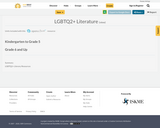
A Guide for Educators Working with Youth to Support Bystander Intervention in Transphobic and Sexual Violence
- Subject:
- Education
- Material Type:
- Primary Source
- Author:
- Canadian Human Rights Trust
- Date Added:
- 11/21/2019

A Guide for Educators Working with Youth to Support Bystander Intervention in Transphobic and Sexual Violence

Educational playlists are selections of films on themes that tie in with Canadian curricula and address the important issues of the day. Many of the playlists are also linked to our study guides

The final report on the first national climate survey on homophobia, biphobia, and transphobia in Canadian schools.

LGBTQ2+ Literary Resources - Select the appropriate grade level from the table of contents to see a list of suggest resources shared by OutSaskatoon and fYrefly.

Mini Lesson for Beauty: Beyond the Binary
Themes:
Diversity/Pluralism – Identity
Family Studies / Home Economics – Child Development, Family Diversity and Challenges
Health / Personal Development – Human Growth and Development, Identity
Recommended Ages: 12 and up
Beauty: Beyond the Binary follows five gender-diverse youth as they share experiences (both affirming and challenging) that have influenced their journey towards becoming and expressing their authentic selves.
Activities are included.

Curriculum Connections to: Language Arts, Civics/Citizenship, Diversity/Pluralism, Family Studies
Every single person on this planet will experience gender and sexuality in a variety of ways. This playlist asks its viewers to consider the multitude of stories experienced by 2SLGBTQIA+ individuals and communities in order to create deeper, more empathetic understandings of what it means to be 2SLGBTQIA+ and additionally, to open up conversations about what it means for anyone to experience gender and sexuality.
Educators in particular can use this playlist with high-school-aged students to challenge stereotypical and prejudiced narratives about 2SLGBTQIA+ people, while adding complexity to the experiences of folks who identify as being part of this community. As students’ understanding and experiences of gender and sexuality continue to evolve, films like these can be important tools for them to see themselves or loved ones represented, to develop their capacity to discuss these issues, and to deepen their empathy for those whose experiences might be different from their own.

Curriculum Connections to: Language Arts, Civics/Citizenship, Diversity/Pluralism, Family Studies
Children pick up ideas about gender beginning in their infancy; they constantly observe the variety of families and forms of expression around them, and they might be curious about the feelings they have for others. The films on this playlist will help to open up conversations about gender identity and sexual orientation in age-appropriate ways for primary-school children.
Educators in particular can use this list to prompt thinking and discussion about how people might express gender or identify with one gender or another; or about why some families might look different from others; or about what love can look like. The films can be used as entry points to learning about gender stereotypes, name calling and safe spaces.

Growing up, Evie Ruddy didn’t quite feel like a girl, or a boy, and resisted gendered expectations. Only recently, with the growing awareness of non-binary identities, did Evie move toward a more androgynous gender performance and begin using they/them pronouns. Un/tied Shoes tells the story of how gender conventions have impacted Evie’s life, with footwear as markers along the way.
Un/tied is presented as an online shoe company, but visitors expecting to browse the latest styles will instead find a first-person account of self-actualization and contesting categorization. Thanks to gendered fashion industry conventions, buying shoes and clothes that reflect their identity has been a lifelong challenge for Evie. Framing their story as an online shopping experience underscores the hardship many non-binary and transgender people face trying to reflect their gender identity in their outward appearance. It’s an everyday illustration of the deep-rooted mores and social codes that determine who can wear what, and in which circumstances.
With Evie as our guide, Un/tied invites us to step into a future with more options, fewer labels, and shoes that come in all sizes, for all people.